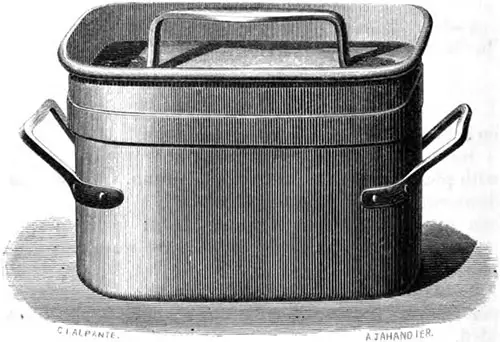Braising - Vintage Cooking Process

Braising Stew Pan © 1869 The Royal Cookery Book
Braising is another form of stewing, and a more delicate one. Braised meat is given but a very little liquid, and is usually surrounded with vegetables and herbs, cooked a long time, and highly seasoned.
Braising is a combination of roasting and stewing small joints of meat in a shallow stew pan. it is a favorite method of cooking with the French, and is supposed to bring out an unusually fine flavor and aroma.
Braising is now very popular and fashionable as well, since the attractive casseroles have been put on the market. The method implies long, slow cooking in a covered dish with a small amount of liquid after the surface has first been seared by quick, dry heat.
The pan in which a braise is to be made should always be lined with slices of bacon, carrot, onions and herbs, upon which the meat is placed. It is usually moistened with stock or stock and wine.
Delicate Meats
The more delicate meats, such as sweetbreads, fillets, fowls and turkeys are sometimes covered with buttered paper; this is done to prevent the heat from the top of the pan scorching or imparting too much of a roast flavor to the meats which are to be braised.
Occasional basting during the process of this method of cooking is essential. When done, the meat is taken up, the fat removed from the vegetables and gravy, which latter is then reduced, strained and blended with some kind of gravy or thin sauce.
Braising is a more elaborate method of stewing and even less water is used when it is employed. The meat is usually browned first, and various vegetables are added in the process of cooking it. Sometimes no water at all is used, but a small quantity of vinegar is substituted. This has the effect of making the meat even more tender.
Rules for Braising
Braising is a kind of combination of stewing and baking, both operations being carried on at the same time. A braising-pan has a deep cover, on which live charcoal is placed.
The lid is air-tight to prevent evaporation, and the meat cooked in this way absorbs all the flavors of the stock in which it is cooked, and also of the vegetables cooked with it. The process should be very slowly conducted. When putting the meat into the pan proceed thus.
Take different vegetables in suitable proportions, using carrot, turnip, onion, sprig of parsley, thyme and marjoram, a bay leaf, some celery, and if possible some tomatoes.
Slice the vegetables and lay them with the herbs at the bottom of the pan, place the meat on the vegetables, and pour in sufficient strong second stock to come half way up the meat.
Cook very slowly until the meat is tender. Then place it on a hot dish, strain the stock and boil rapidly to a glaze to pour over.
To obtain the effect of braising without a braising-pan, put the meat into an ordinary meat-kettle or saucepan in the way that I have described, simmer until tender, then place on a baking-sheet and put it in the oven to brown while the stock is reduced to a glaze.
Wine is sometimes added to the stock.
Table Talk: The American Authority upon Culinary Topics and Fashions of the Table, Vol. XXVII, 1912, A Series of Articles Published Throughout the Year. Published Monthly by The Arthur H. Crist Co., Cooperstown, NY. A Monthly Magazine Devoted to the Interests of American Housewives, Having special reference to the Improvement of the Table. Marion Harris Neil, Editor.
Braising is stewing and baking (meat). Meat to be braised is frequently first sautéd to prevent escape of much juice in the gravy. The meat is placed in a pan with a small quantity of stock or water, vegetables (carrot, turnip, celery, and union) cut in pieces, salt, pepper, and sweet herbs.
The Braising Process
The pan should have a tight-fitting cover. Meat so prepared should be cooked in an oven at low uniform temperature for a long time. This is an economical way of cooking, and the only way besides stewing or boiling of making a large piece of tough meat palatable and digestible.
Fannie Merritt Farmer, The Boston Cooking-school Cook Book, Revised Edition, Boston: Little, Brown, and Company (1912), p. 22
